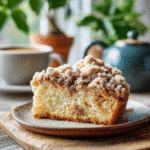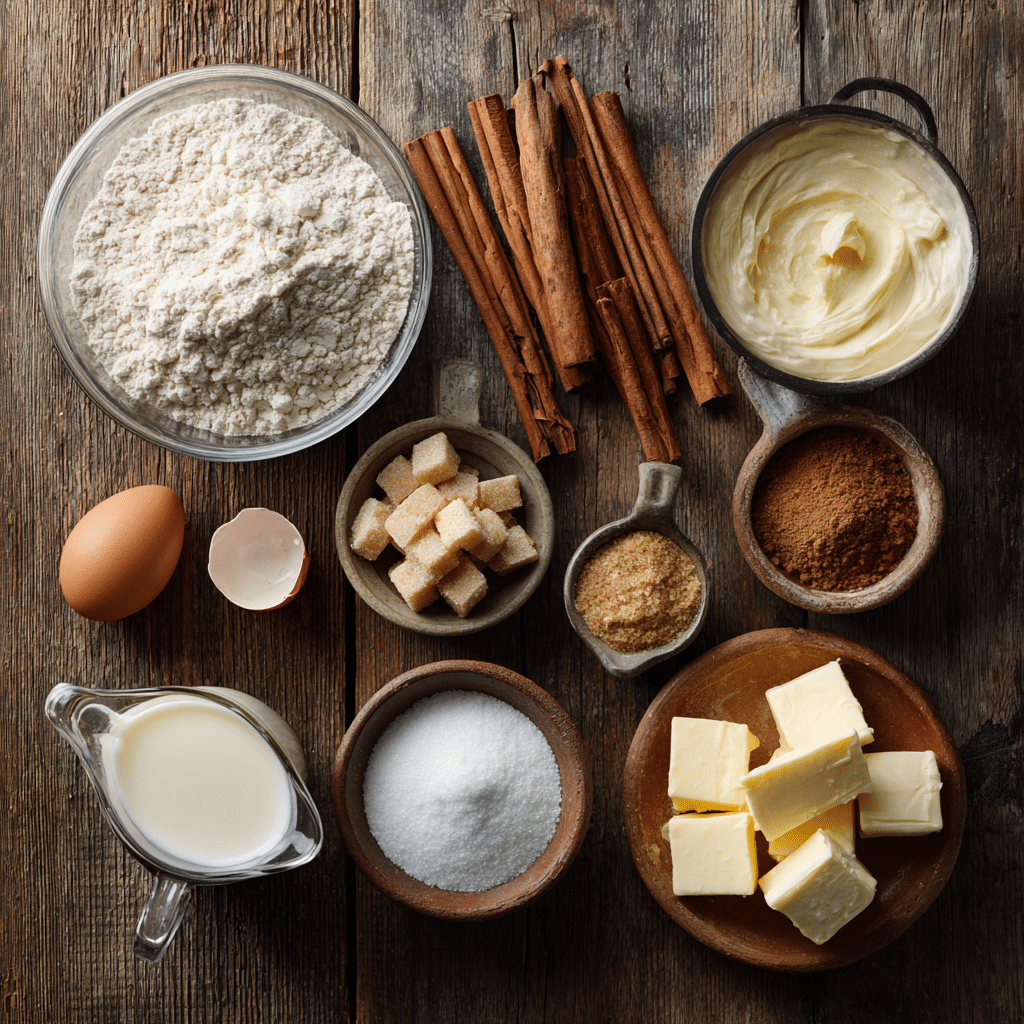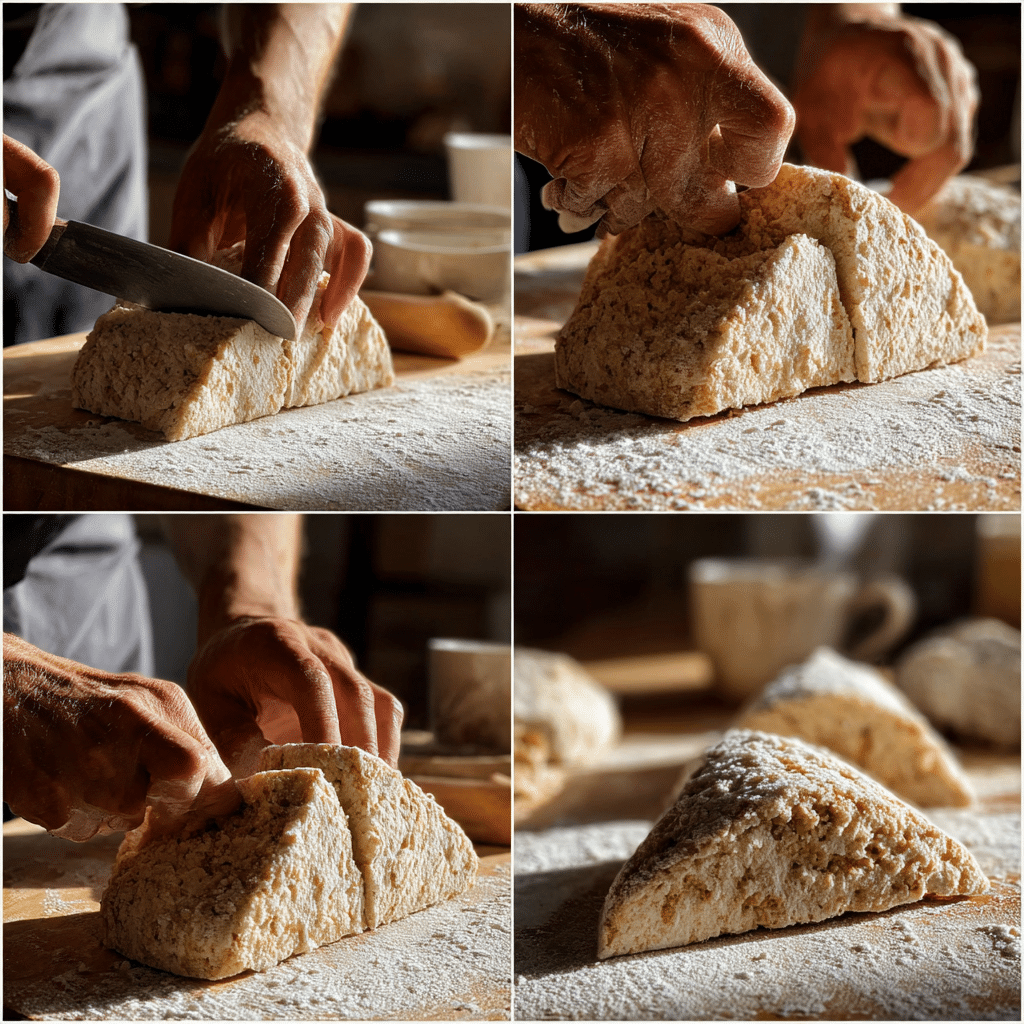Looking for a bakery-style breakfast that blends the buttery richness of scones with the sweet comfort of coffee cake? Coffee Cake Scones are the perfect marriage of crumbly texture and cinnamon-sugar goodness—ideal for those slow mornings or brunch gatherings. In this guide, we’ll dive deep into what makes coffee cake scones so irresistible, how to bake them from scratch, common mistakes to avoid, and even explore the mystery behind the “15-minute scone rule.” You’ll also discover tips to elevate your scones with toppings, find out how to store them properly, and get answers to your top baking questions.
Discover great ideas like the tangy twist in our Hibiscus Lemonade Recipe if you’re looking for a refreshing drink to pair with your scones.

Table of Contents
Table of Contents
What Are Coffee Cake Scones?
What Makes a Scone a “Coffee Cake” Scone?
At first glance, a scone and a coffee cake might seem worlds apart. But when you combine their best features—flaky texture, buttery richness, and cinnamon crumb topping—you get a coffee cake scone: a hybrid that feels indulgent yet satisfying. Unlike traditional scones that often lean toward fruity or savory, coffee cake scones focus on the sweet, spiced flavor profile of classic American coffee cakes. Think soft crumb inside, golden crust outside, and that signature streusel crumble baked right on top.
The defining characteristics include:
- Crumb topping made with flour, butter, cinnamon, and sugar
- Moist interior balanced with just enough density
- Mild sweetness (not overpowering) ideal for morning pairings
Coffee cake scones often have a rustic, uneven look—don’t expect uniform perfection. The charm lies in their homemade, artisan feel.
Print
Coffee Cake Scones
- Total Time: 43 minutes
Description
Buttery, flaky scones topped with a cinnamon crumb and sweet glaze
Ingredients
Scone Dough
2 cups all-purpose flour
1/3 cup granulated sugar
1 tablespoon baking powder
1/2 teaspoon salt
1 teaspoon ground cinnamon
1/2 cup (1 stick) cold unsalted butter, cubed
1 large egg
1/2 cup heavy cream (plus more for brushing tops)
1 teaspoon vanilla extract
Crumb Topping
2 tablespoons all-purpose flour
2 tablespoons brown sugar
1/4 teaspoon cinnamon
1 tablespoon cold butter, cubed
Optional Glaze
1/2 cup powdered sugar
1 tablespoon milk
1/4 teaspoon vanilla extract
Instructions
Preheat oven to 400°F (200°C). Line a baking sheet with parchment paper.
Mix dry ingredients: In a large bowl, whisk together flour, sugar, baking powder, cinnamon, and salt.
Cut in butter: Add cold cubed butter. Use a pastry cutter or fingers to combine until mixture resembles coarse crumbs.
Combine wet ingredients: In a small bowl, whisk egg, heavy cream, and vanilla. Pour into the dry mix and stir just until combined.
Shape the dough: Turn out onto a floured surface. Knead gently and shape into a 7–8 inch disc. Cut into 8 wedges.
Make crumb topping: Combine flour, brown sugar, cinnamon, and butter. Pinch together until crumbly. Sprinkle on top of each wedge.
Chill: Place scones on the prepared baking sheet and chill for 15 minutes.
Bake: Bake 15–18 minutes or until tops are golden and a toothpick comes out clean.
Optional glaze: Whisk glaze ingredients and drizzle over cooled scones
- Prep Time: 10 minutes
- Cook Time: 18 minutes
- Category: Breakfast, Brunch, Baking
- Cuisine: American
Origins and Evolution of Coffee Cake Scones
The concept of coffee cake originated in Europe but was popularized in America, especially in Jewish and German immigrant communities where yeast-based crumb cakes were often served with coffee. Over time, home bakers merged this with the British scone tradition—a denser, less sweet baked good—to create a version that was quicker, crumblier, and full of cinnamon-laced nostalgia.
The rise of this scone variant aligns with the growing interest in hybrid pastries, where traditional recipes are adapted with trending flavors and textures. Bakeries across the U.S. began offering coffee cake scones as a morning staple alongside croissants and muffins—especially in artisan bakeries and local cafés.
Ingredients That Make the Perfect Coffee Cake Scones

Core Ingredients and Flavor Profile
At the heart of every coffee cake scone is a handful of pantry staples. Each one plays a vital role in texture, moisture, and flavor. Here’s a look at the key ingredients:
- All-purpose flour: Provides structure
- Cold butter: Crucial for flakiness; it melts while baking, creating pockets of steam
- Granulated sugar + brown sugar: Adds sweetness and depth
- Baking powder: Leavens the scones for that perfect rise
- Salt: Balances sweetness
- Ground cinnamon: Signature spice of coffee cake
- Heavy cream or buttermilk: Adds richness and tenderness
- Egg: Helps bind and enrich the dough
- Vanilla extract: Brings in warm, sweet flavor notes
This flavor profile mirrors traditional coffee cake but with a denser, biscuit-like bite.
Common Optional Add-ins (Cinnamon, Nuts, Etc.)
Want to upgrade your coffee cake scones? Here are popular mix-ins:
| Add-In | Purpose | Notes |
|---|---|---|
| Cinnamon chips | Extra spice | Stir into dough |
| Chopped pecans or walnuts | Crunch & texture | Toast them for flavor |
| Raisins or dried cranberries | Chewy sweetness | Balance with moisture |
| Streusel topping | Coffee cake texture | Adds crunch and spice |
Adding these can personalize your scones while staying true to the coffee cake flavor.
The Difference Between Scones and Biscuits
Texture and Ingredient Comparison
Though they may look similar, scones and biscuits are quite different. The main differences lie in:
| Feature | Scone | Biscuit |
|---|---|---|
| Texture | Crumbly, dense | Fluffy, airy |
| Sugar content | Higher | Minimal |
| Fat type | Butter or cream | Often shortening |
| Moisture | Slightly drier | Soft and steamy |
Coffee cake scones especially lean into sweetness and density, whereas biscuits are more neutral and light.
Baking Method and Regional Influence
Scones often originate from British tea-time culture, baked as rounds or wedges and served with jam or clotted cream. Biscuits, however, are deeply rooted in Southern American cuisine, where they’re layered, flaky, and often savory.
Coffee cake scones represent a fusion—borrowing structure from British scones but using ingredients and flavors that echo American coffee cakes.
How to Make Coffee Cake Scones from Scratch

Step-by-Step Recipe Instructions
Here’s a streamlined guide for making 8 delicious coffee cake scones at home:
- Prep dry mix: In a large bowl, whisk 2 cups flour, 1/3 cup sugar, 1 tbsp baking powder, 1 tsp cinnamon, and 1/2 tsp salt.
- Cut in butter: Use a pastry cutter to incorporate 1/2 cup cold cubed butter until crumbly.
- Wet mix: In another bowl, mix 1 egg, 1/2 cup heavy cream, and 1 tsp vanilla. Add to dry mix.
- Mix and shape: Stir until just combined. Turn out dough and gently knead into a disc. Cut into 8 wedges.
- Topping: Mix 2 tbsp flour, 2 tbsp brown sugar, 1/4 tsp cinnamon, and 1 tbsp cold butter. Sprinkle over each scone.
- Bake: Bake at 400°F (200°C) for 15–18 minutes or until golden brown.
Pro Tips for Mixing and Shaping
- Don’t overmix. Stop as soon as the dough comes together.
- Keep butter and cream cold to ensure a tender, flaky crumb.
- Chill the cut scones for 10 minutes before baking to prevent spread.
Looking for inspiration? Try our Cottage Cheese Flatbread for another easy, flavorful bake.
Understanding the 15-Minute Rule for Scones
What Is the 15-Minute Rule?
The “15-minute rule” in scone making refers to chilling your scones for at least 15 minutes before baking. This helps:
- Solidify the fat, resulting in flakier texture
- Prevent excessive spreading during baking
- Develop a crisp crust and moist center
This short chilling period also lets the gluten relax slightly, making the scone more tender.
How It Affects Texture and Rise
When cold butter melts during baking, it creates steam. This steam gives scones their layered lift and crumbly texture. Skipping this chill time can lead to flat, greasy scones with no structure.
Pro tip: If your kitchen is warm, refrigerate the dough for up to 30 minutes before slicing.
What to Avoid When Making Coffee Cake Scones
Common Mistakes (Overmixing, Wrong Butter Temp)
Even seasoned bakers can go wrong. Here’s what to steer clear of:
| Mistake | Result |
|---|---|
| Overmixing | Tough, dense scones |
| Warm butter | No flakiness, greasy bake |
| Too much liquid | Sticky dough, uneven bake |
| Skipping chill time | Flat, spread-out scones |
| Overbaking | Dry, crumbly texture |
Fixes and Troubleshooting Tips
- If dough is too sticky: Add 1 tbsp flour at a time until manageable.
- If scones don’t rise: Check freshness of baking powder.
- If too dry: Brush tops with extra cream before baking for moisture.
Don’t miss our Red Lobster Crabfest Recipe for a savory balance to your baking day.
Coffee Cake Topping Ideas to Elevate Your Scones
Classic Crumb Topping for Coffee Cake Scones
The iconic feature of a coffee cake scone is its crumb topping—that golden, crunchy crown that sets it apart. Here’s a quick mix for the classic topping:
Ingredients:
- 2 tbsp all-purpose flour
- 2 tbsp light brown sugar
- 1 tbsp cold butter
- 1/4 tsp cinnamon
Instructions:
- Mix with fingertips until crumbly
- Sprinkle generously on top of shaped scones before baking
This topping melts slightly into the dough while baking and leaves a crisp, cinnamon-kissed layer that mimics the classic coffee cake texture.
Sweet Glaze and Drizzle Variations
Want to push your scones over the top? Add a drizzle! Try one of these post-bake options:
| Glaze Type | Ingredients | Flavor Notes |
|---|---|---|
| Vanilla glaze | 1/2 cup powdered sugar, 1 tbsp milk, 1/4 tsp vanilla | Sweet, creamy |
| Cinnamon glaze | Add 1/4 tsp cinnamon to above | Warm and spiced |
| Cream cheese glaze | 2 oz cream cheese, 1 tbsp butter, powdered sugar | Rich, tangy |
Apply once the scones have cooled for best results.
Check out our Quick & Easy Recipes section for more sweet creations that pair well with breakfast bakes.
How to Serve and Store Coffee Cake Scones
Best Ways to Enjoy Them with Coffee or Tea
Coffee cake scones are best served:
- Warm from the oven with a pat of butter
- With coffee—light or dark roast both work well
- Alongside tea, especially spiced chai or English breakfast
- At brunch, paired with fruit and yogurt
Add seasonal fruit (like strawberries or sliced apples) to make it a fuller plate.
Proper Storage and Reheating Methods
Room Temp: Store in an airtight container for up to 2 days
Fridge: Up to 5 days, though texture may firm up
Freezer: Freeze unbaked wedges or baked scones for up to 2 months
Reheating: Microwave 10 seconds or bake at 300°F for 5–6 minutes to refresh texture.
Looking for a fresh side? Don’t miss our Gluten Free Chickpea Pasta Salad—great for brunch boards.
FAQs About Coffee Cake Scones
What is the 15 minute rule for scones?
The 15-minute rule refers to chilling the scone dough for at least 15 minutes before baking. This ensures the butter remains cold, helping the scones rise properly and develop a flaky, tender texture.
Why was it called coffee cake?
Coffee cake was traditionally served with coffee, not necessarily made with it. It features a sweet, spiced flavor, often with cinnamon and crumb topping, designed to complement a warm drink.
What is the basic difference between a scone and a biscuit?
Scones are sweeter, denser, and often include eggs, while biscuits are fluffier and savory, usually with no sugar. Coffee cake scones blend the density of scones with the sweet topping of coffee cake.
What to avoid when making scones?
Avoid overmixing, using warm butter, skipping the chill step, and overbaking. These mistakes lead to tough, dry, or flat scones instead of crumbly, golden perfection.
Conclusion
Coffee cake scones are the ultimate mash-up—merging the cozy spice of coffee cake with the crumbly joy of a scone. With simple ingredients, a bit of chill time, and the right topping, you can create a pastry that’s both impressive and incredibly easy to pull off. Whether you’re pairing it with your morning brew or serving it for brunch, this scone style is sure to become a go-to favorite.
Looking for inspiration? Try our Red Lobster Crabfest Seafood Boil for your next savory dinner idea!
